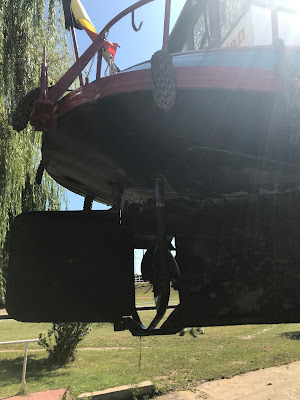Barge Date: 08--2019
Lionel on Dry Land
This is a first for us. The boat must come out of the water so a survey can be made on the hull. Would you want to insure a 100 year old metal boat without knowing if she will float?We drove Lionel down the Soane from Auxonne to Saint Jean de Losne (SJdL) early in the morning and made the turn for the Burgundy Canal and the entry lock. Our luck: two boats waiting to go through also and both too large to join them. Then our luck continued; the second boat was for haul out as well so we got a preview of what would happen.
Lionel weighs something like 30 tons. If there was a crane big enough to handle this weight we could be lifted out with straps. Not here in SJdL. There is a dry dock but it was not available. So we go to the people that have a hydraulic trailer. You pull your boat up to a ramp, and the trailer is rolled underneath to support the boat. Much maneuvering to get everything located just right, then with the big tractor they pull you out and hope it does not fall off.
 |
| This was the surprise: our little shell friends from Belgium years, I think. No wonder my depth sounder did not work. |
When I saw the shells I wondered how they would clean off. Would they? The staff used a very strong power washer, and it had no problems peeling the little things from the hull. Lots of them. After the boat was moved away, you walked in them and they gave way underfoot. Snap, Crackle and Pop. We were on hand for a few more days, and the smell of them under the sun was something. I suspect there is still something in the air.
Here is a video of the haul out. Below are pictures of the barge as it rested on supports and the trailer removed.
 | ||
| Even with some thumps on the prop by the captain and underwater hard stuff, the prop was in good shape. The prop is about 84cm in diameter; big and robust. |
 |
| This is a anode, one of about 12 on the boat. These are magnesium and used as sacrificial metal to lessen metal deterioration. |
 |
| Underwater thru holes on boat used as drains. |
The following day, the surveyor arrived and quickly did his work. He marked out the boat and began testing with a hammer. He was listening for sounds that to his ears might be a problem. He did some grinding to determine depth of some pitting and then used an ultrasound to measure hull thickness. While he made some suggestions, there were no significant problems. He and I measured the displacement of the prop and rudder and did not find problems. He will create a written report for the insurance company and a bill for me.
The boatyard people made some offers as to how to proceed. They will further clean the hull and apply a coating that protects the metal and maybe fights off organic growth. The shell animals should not be a problem where we are now operating. The coating plus some new electronics we installed last spring will work well to prevent loss of hull metal.
They will replace the anodes on the boat, cut some metal that is too close to the prop (as suggested by the surveyor and they agreed), make the screen over the water intake for the engine removable and will place additional ballast on the fore-deck for me to place in the forward hold to help adjust for the extra weight of the batteries added last year at the stern. They will also do a further inspection of thru-hull holes as this is the number one reason boats tend to sink; not holes in the hull.
We are off on a land tour and I look forward to seeing Lionel with all the work complete.



















No comments:
Post a Comment